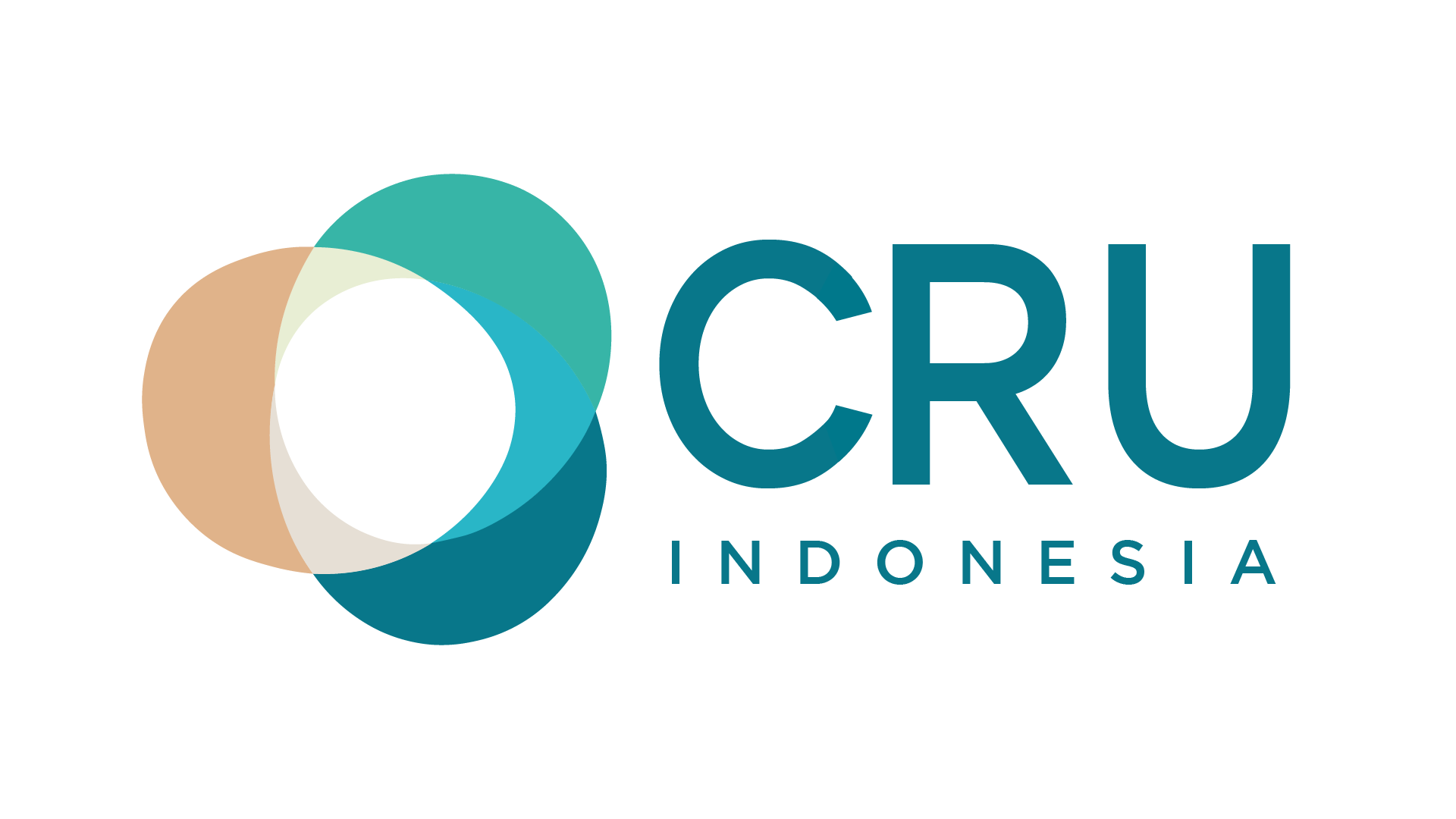“Haunted” at the Boston Public Library Addresses Land Back through Native Comedy Theater
6 Februari 2025agnes
By Hartman Deetz (Mashpee Wampanoag)
It all started with a warm and personal invitation to attend the rolling premiere of Company One’s stage production of “Haunted” at the Boston Public Library. I excitedly confirmed my “pay as you can” ticket and spread the word among some friends. The opening night on January 25, 2025, was an evening packed with the stage production itself, an after-party with music by Red Hawk Singers and Wamptronica (Wampanoag), art by Mea Johnson (Apache), and food provided by Frybread Catering. It was a full event! How could I say no?
The night of the event arrived, and I put on my good shoes and jewelry and headed downtown. When I arrived, the lobby was full of people, a whos who of the Boston Indigenous community. The buzz of conversation and refreshments filled the air. Tables were set up by local Indigenous organizations, and of course, being a library, there was a display of highlighted books by Indigenous authors. With the atmosphere bubbling, the ushers began the gentle push to the seats. It was a packed house.
“Haunted” is the first Native-produced show to grace the stage at Boston Public Library, written and directed by Tara Moses (Mvskogee and Seminole). I wanted to be there to help support this accomplishment and see the show itself, but I knew very little about the story other than it was a comedy with two Native ghosts. While I don’t intend to spoil the story, I can say with confidence that most Native people need only know that much before they begin to laugh, their mind racing with the possibilities with well-matched tropes of Indian burial grounds and spirit names, you name it, “Haunted” delivers in the most Indigenous ways possible.
Bradley Lewis, Katherine Callaway, Evan Turissini, Tanya Avendaño Stockler. Photo by Ken Yotsukura Photography.
The humor is Indigenous through and through, turning many of these old tropes on their heads but at the same time allowing free flow into realms of pop culture and techie jokes. However, woven throughout are strands of deep and serious issues. Ranging from personal to spiritual and social, looking at relationships within Native communities and between Native communities and our neighbors. By the play’s end, it had touched on boarding schools, alcoholism, stereotyping, gender binaries, sexuality, brotherhood, grief, and forgiveness but punctuated in perfect rhythm with the humor that allows the story to take us further and further and more invested as we watch.
Chingwe Padraig Sullivan, Katherine Callaway, Evan Turissini, Tanya Avendaño Stockler, Bradley Lewis. Photo by Ken Yotsukura Photography.
Bradley Lewis (Acoma Pueblo) as Aaron and Chingwe Padraig Sullivan (Shinnecock Montaukett) as their brother Ash really give an amazing performance, spending the whole play on stage as we see a rotation of characters including JāQuan Malik Jones as Vincent, Evan Turissini as white man and Katherine Callaway and Tanya Avendano Stockler as white girl 1 and 2 respectively. I found it humorous that the white characters lacked names, something I did with my production of “We Are The Land” as a sort of rebuttal to the common experience for Native actors. I, myself, have played both Indian Number 2 and Indian Number 3 in two separate film shorts.
Chingwe Padraig Sullivan, JāQuan Malik Jones, Bradley Lewis. Photo by Ken Yotsukura Photography.
In an interview published in the production brochure, Tara Moses remarked on the work of the non-Native actors in the production, praising them for their ability to approach the work with humility and understanding. With a long history of being written as two-dimensional characters, Native storytelling in theater and film often takes the task of punching up at the normalization of whiteness, and this play is no exception. Many cultural divides and stereotypes are the butt of the jokes that engage the Native audience in a unique way that lets us know that this play is primarily for us. Laughter can be the best medicine, the saying goes, and white actors willing to take on the role reversal help to make this happen.
But it’s not only the racial and cultural divides that make this work speak directly to Native audiences. Sitting in the audience, I was surprised to hear my Tribe, the Mashpee Wampanoag, mentioned suddenly, and I thought, “How nice they included us as the local Tribe,” but then they even went a step further, mentioning tribal council “Chairman Weeden” by name. In speaking with Moses, she told me that these aspects of local Tribes’ figureheads, as well as the local problematic academic institution, are changed out to suit the performance venue.
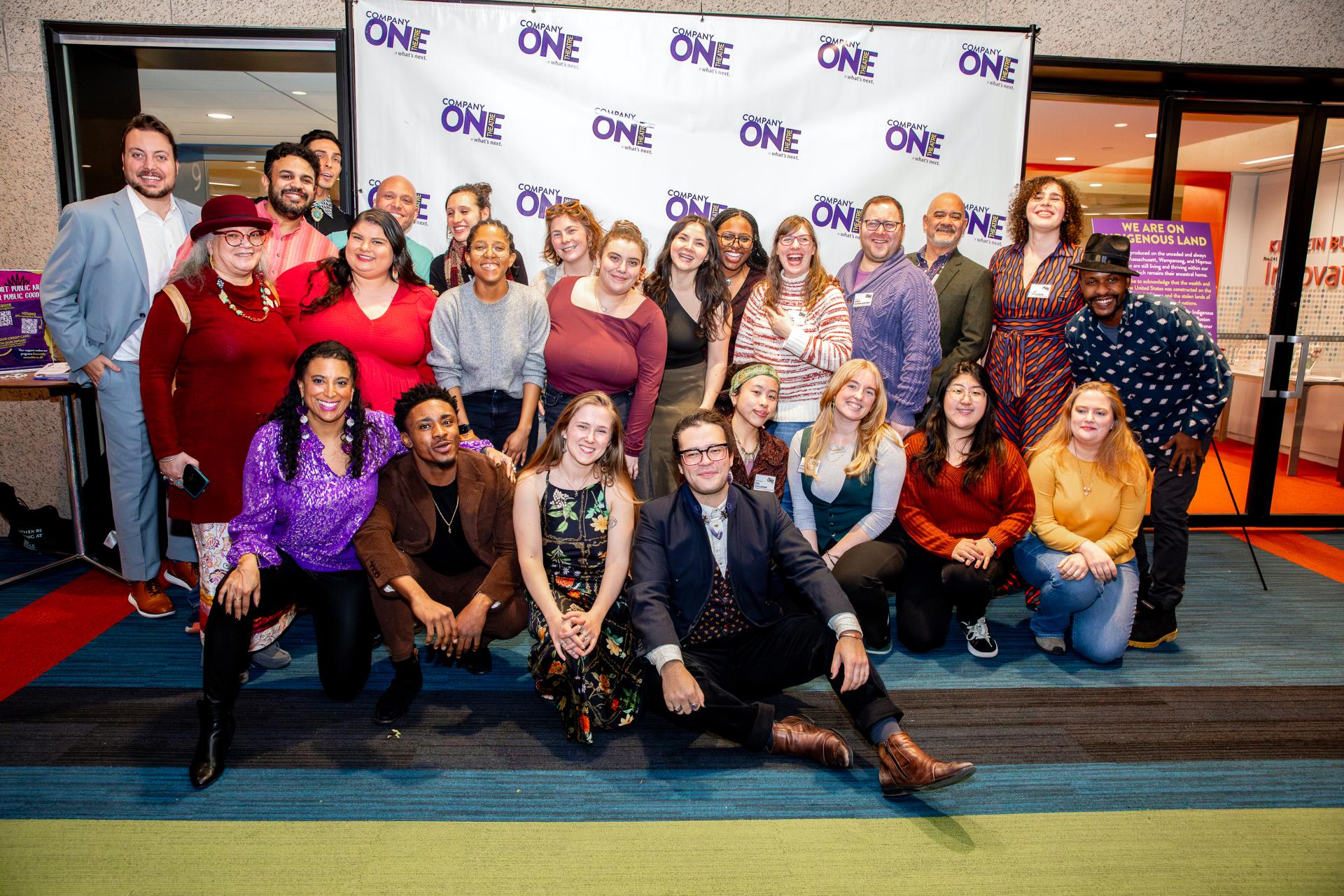
The cast of “Haunted” and special guests. Photo by Lauren Miller.
In the scene that delves into the topic of Land Back, there are a number of great jokes about how our society is often uninformed about their neighbors in local Native communities, highlighting the powerful computers we all have in our pockets and the ease with which we can access information. As the play turns to the audience and breaks the fourth wall, asking the people in attendance to google the “Land Back” movement, this hyper local focus on the people of the area becomes a strong and pointed message. “There is still a Tribe right here…” and beyond the encouragement to use Google, the brochure had information regarding Native land trust organizations that do the work of helping Native people regain title to our homelands.
But the play also highlights a different common experience for Native people, that sense of not belonging. While the two characters, Ash and Aaron, never reveal what Tribe they are from, it is made known that they are not from the local Tribe, and through this, the play explores the tensions of acceptance and doubt of whether other Tribes can truly belong amongst those whose lands they also occupy. As a strike against pan-Indianism, it is important to recognize our distinct tribal cultures and histories. While the dominant culture may see us as all being the same, that is certainly not how we see ourselves. With tens of thousands of years of history, in the last 400-150 years our shared experience of colonization means that in our lived experience, we have far more in common with each other than that which divides us. Tara Moses’ work does a beautiful job of both honoring those distinctions and underscoring those common bonds between us.
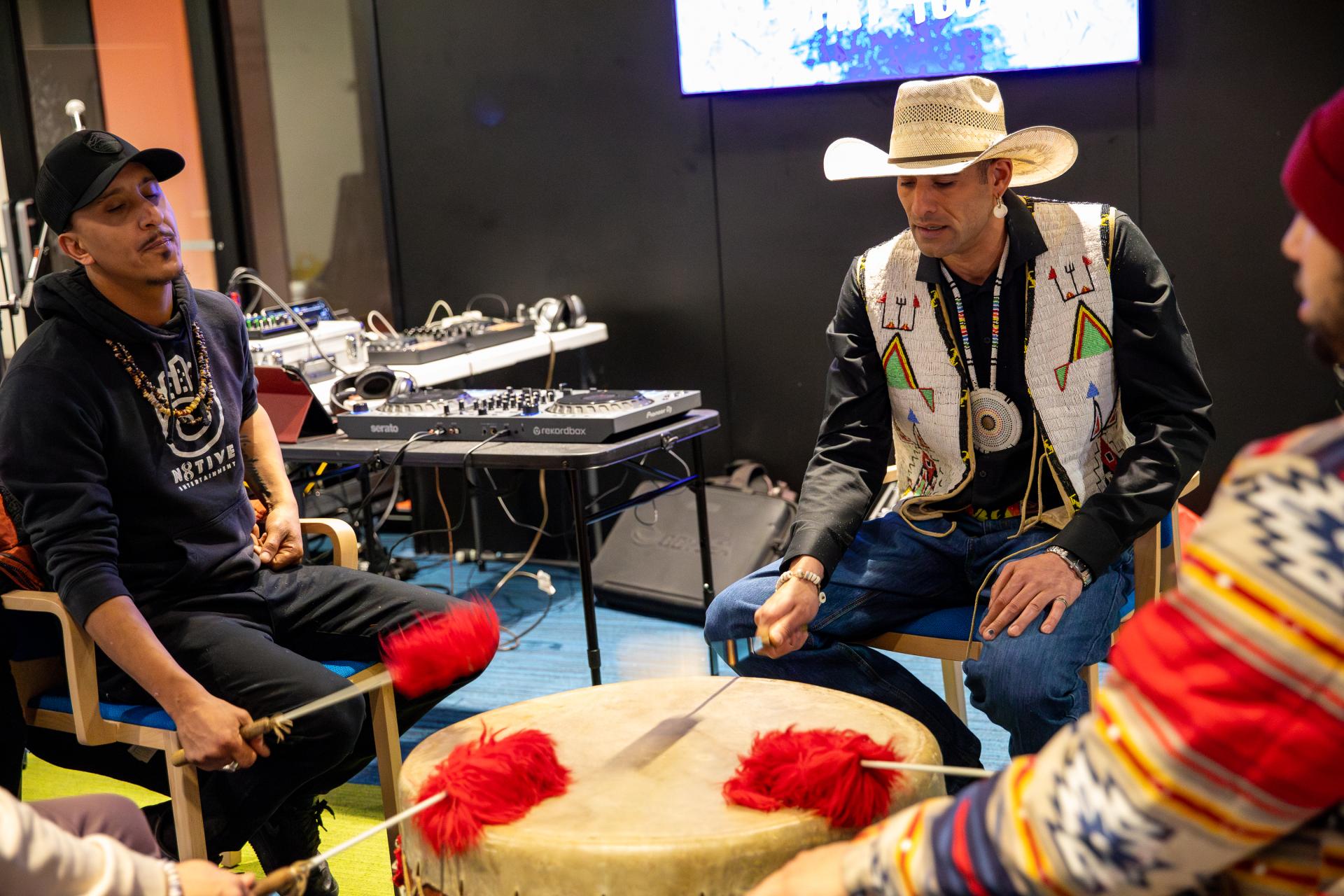
Red Hawk Singers. Photo by Lauren Miller.
As the play concluded with thunderous applause, the audience filtered out to the lobby, Red Hawk Singers led by CheeNulKa Pocknett (Mashpee Wampanoag) provided an honor song, and the crowd was alive and bright, with conversations between strangers and friends everyone had to share something about the piece they had just seen. After the honor song from Red Hawk, Wamptronica took the stage with a mix of hip-hop, house, and funk. The festive mood rose to a crescendo when, at last, the cast came out and made their appearance, met with elation from the crowd. The cast and crew were flooded with photos, flowers, and praise. The show was quite clearly a crowd pleaser and a success.
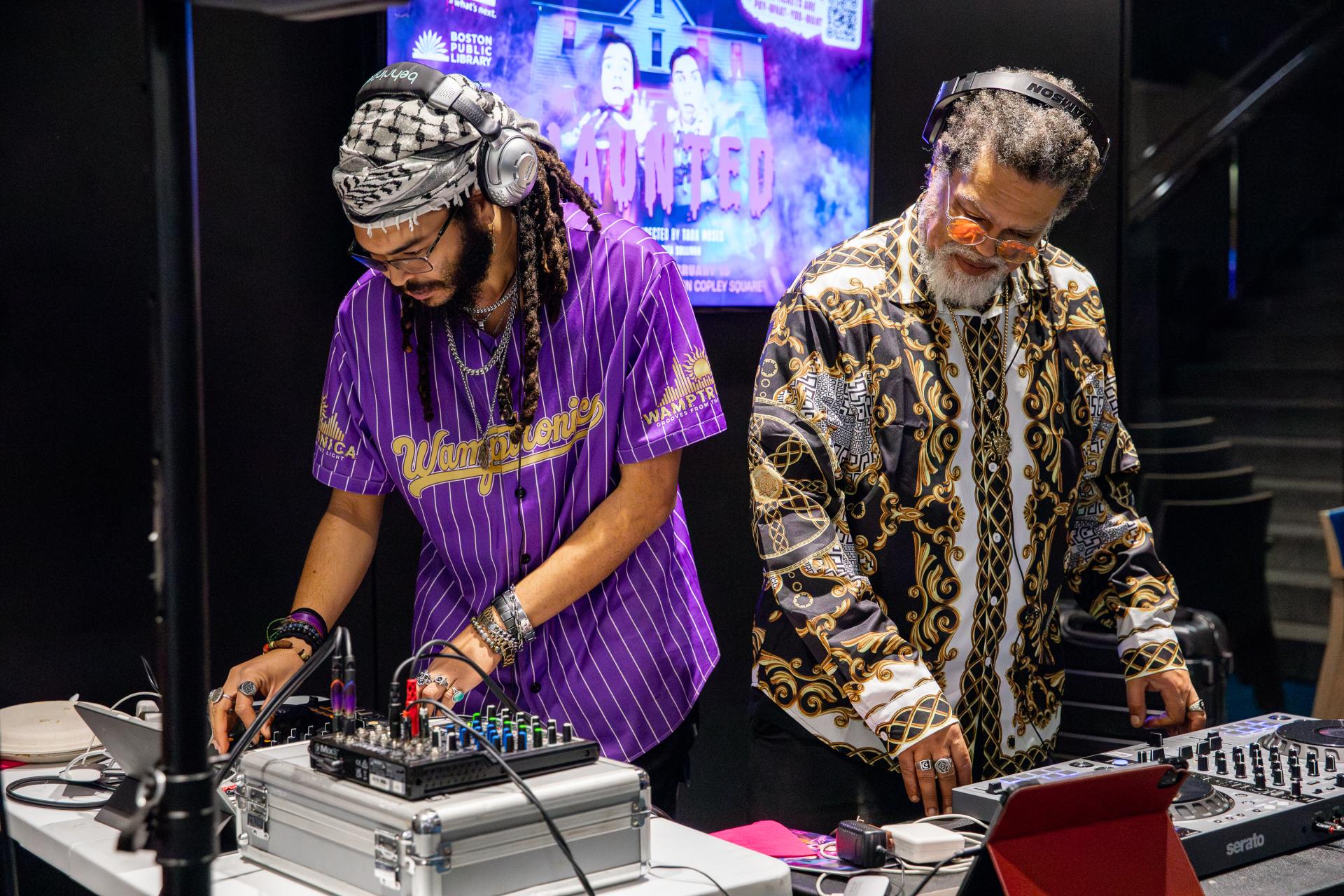
Wamptronica. L-R: Morgan Ziggy Peters and Mwalim Peters. Photo by Lauren Miller.
“Haunted” runs through February 15, 2025. Don’t miss it!
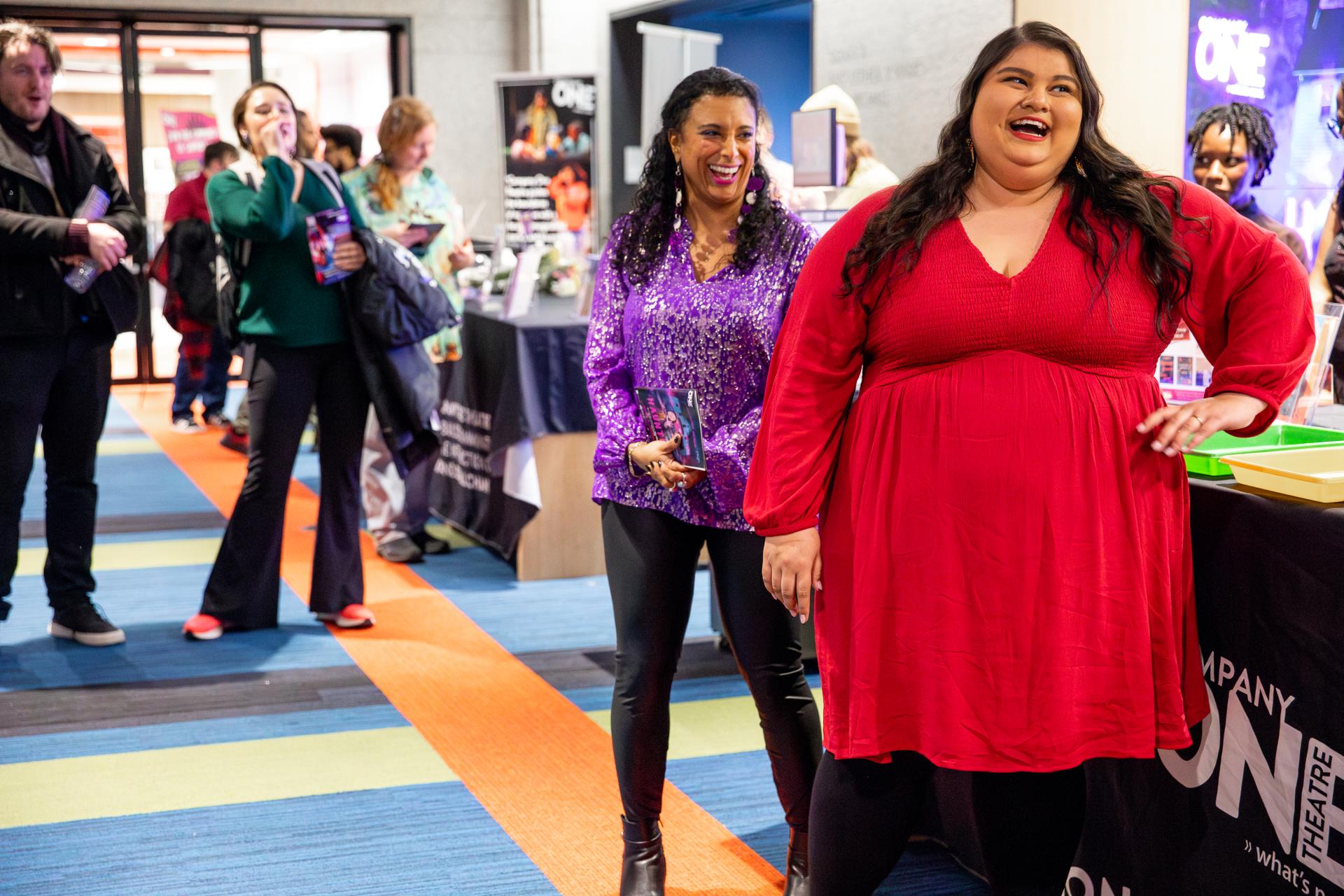
Tara Moses. Photo by Lauren Miller.
–Hartman Deetz (Mashpee Wampanoag) has been active in environmental and cultural stewardship for over 20 years. He is a traditional artist as well as a singer and dancer, having shown his art in galleries and performed for audiences from coast to coast across the U.S..
Read:
Native Theatre Brilliance Rising: An Interview with Playwright Tara Moses
Company One Theatre, in partnership with the Boston Public Library, announces the National New Play Network Rolling World Premiere of HAUNTED
Top photo: Chingwe Padraig Sullivan, Katherine Callaway, Bradley Lewis. Photo by Ken Yotsukura Photography.
